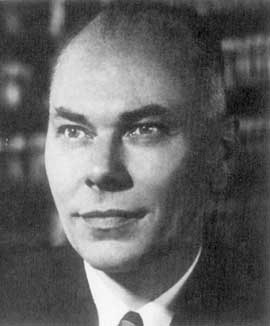


 تاريخ الرياضيات
تاريخ الرياضيات
 الرياضيات في الحضارات المختلفة
الرياضيات في الحضارات المختلفة 
 الرياضيات المتقطعة
الرياضيات المتقطعة
 الجبر
الجبر
 الهندسة
الهندسة 
 المعادلات التفاضلية و التكاملية
المعادلات التفاضلية و التكاملية 
 التحليل
التحليل
 علماء الرياضيات
علماء الرياضيات |
Read More
Date: 26-9-2017
Date: 12-9-2017
Date: 21-9-2017
|
Died: 14 March 1973 in St Louis, Missouri, USA

Howard Aiken studied at the University of Wisconsin, Madison obtaining a doctorate from Harvard in 1939. While he was a graduate student and an instructor in the Department of Physics at Harvard Aiken began to make plans to build a large computer. These plans were made for a very specific purpose, for Aiken's research had led to a system of differential equations which had no exact solution and which could only be solved using numerical techniques. However, the amount of hand calculation involved would have been almost prohibitive, so Aiken's idea was to use an adaptation of the punched card machines which had been developed by Hollerith.
Aiken wrote a report on how he envisaged the machine, and in particular how such a machine designed to be used in scientific research would differ from a punched card machine. He listed four main points [2]:-
... whereas accounting machines handle only positive numbers, scientific machines must be able to handle negative ones as well; that scientific machines must be able to handle such functions as logarithms, sines, cosines and a whole lot of other functions; the computer would be most useful for scientists if, once it was set in motion, it would work through the problem frequently for numerous numerical values without intervention until the calculation was finished; and that the machine should compute lines instead of columns, which is more in keeping with the sequence of mathematical events.
The report was sufficient to prompt senior staff at Harvard to contact IBM and an agreement was made that Aiken would build his computer at the IBM laboratories at Endicott, helped by IBM engineers. Working with three engineers, Aiken developed the ASCC computer (Automatic Sequence Controlled Calculator) which could carry out five operations, addition, subtraction, multiplication, division and reference to previous results. Aiken was much influenced in his ideas by Babbage's writings and he saw the project to build the ASCC computer as completing the task which Babbage had set out on but failed to complete.
The ASCC had more in common with Babbage's analytical engine that one might imagine. Although it was powered by electricity, the major components were electromechanical in the form of magnetically operated switches. It weighed 35 tons, had 500 miles of wire and could compute to 23 significant figures. There were 72 storage registers and central units to perform multiplication and division. The gain an idea of the performance of the machine, a single addition took about 6 seconds while a division took about 12 seconds. ASCC was controlled by a sequence of instructions on punched paper tapes. Punched cards were used to enter data and the output from the machine was either on punched cards or by an electric typewriter.
Having completed construction of ASCC in 1943 it was decided to move the computer to Harvard University where it began to be used from May 1944. Grace Hopper worked with Aiken from 1944 on the ASCC computer which had been renamed the Harvard Mark I and given by IBM to Harvard University. The computer figured highly in the Bureau of Ordnance's Computation Project at Harvard University, to which Hopper had been assigned, being used by the US navy for gunnery and ballistics calculations.
Aiken completed the Harvard Mark II, a completely electronic computer, in 1947. He continued to work at Harvard on this series of machines, working next on the Mark III and finally the Mark IV up to 1952. He not only worked on computer construction, but he also published on electronics and switching theory.
In 1964 Aiken received the Harry M Goode Memorial Award, a medal and $2,000 awarded by the Computer Society:-
For his original contribution to the development of the automatic computer, leading to the first large-scale general purpose automatic digital computer.
This was one of many honours which Aiken received for his pioneering work with the development of computers. These awards were from many countries including the United States, France, The Netherlands, Belgium, and Germany.
Articles:



|
|
|
|
علامات بسيطة في جسدك قد تنذر بمرض "قاتل"
|
|
|
|
|
|
|
أول صور ثلاثية الأبعاد للغدة الزعترية البشرية
|
|
|
|
|
|
|
مكتبة أمّ البنين النسويّة تصدر العدد 212 من مجلّة رياض الزهراء (عليها السلام)
|
|
|